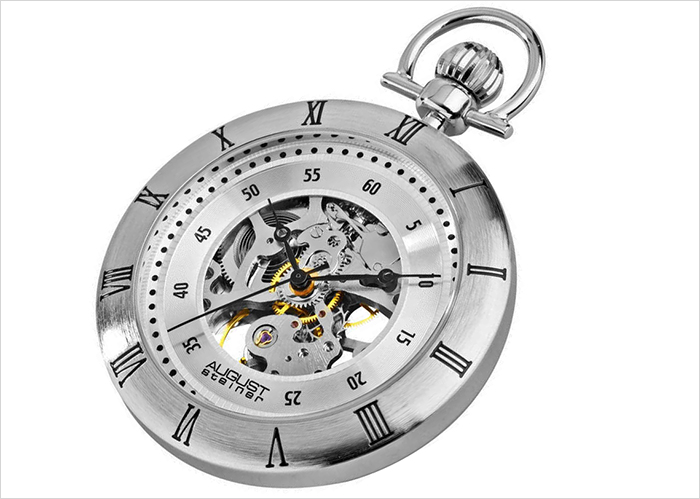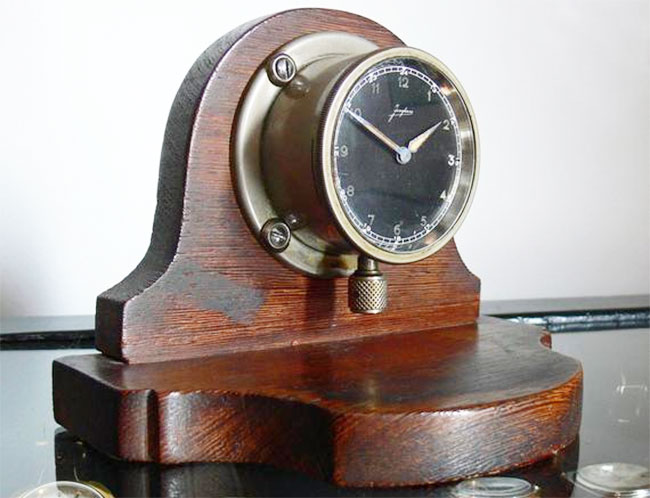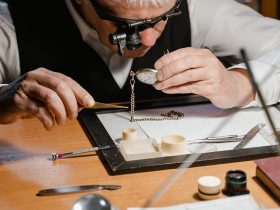American pocket watches never go out of style. Their classic designs and superb durability never goes of style.
Behind every US-made pocket watch is a colorful history that every collector should know.
These tidbits of information about the famous pocket watchers in the United States will help you discern: which brand is the best? Which trade name is truly rare?
We have also listed down the collectible antique models from each US pocket watch manufacturers.
Ball Watch Co. pocket watch (1879 to 1969)
American pocket watches were redefined when Webb Ball established timepiece standards to be used in railway operation. Thus, the railroad pocket watches were conceived. The company often used movements from Hamilton, Waltham, Illinois, Elgin, E.Howard and Hampden.
Ball pocket watches are listed among the most collected rare American pocket watches. The rarest are marked with BALL & Co.
Columbus pocket watch (1874 to 1903)
Dietrich Gruen laid the foundations of the Columbus Watch Co. in Ohio. Columbus pocket watches made before 1882 have watch movements imported from Switzerland.
The company relocated to Cincinnati in 1898. Columbus pocket watch sizes are available in 18s, 16s, 6s, and 4s.
In 1984, their name became the New Columbus Watch Company and made pocket watch grades like Columbus King, Railway King, Time King, Champion, and North Star.
South Bend Watch Company pocket watch (1903 to 1929)
In 1903, the former Columbus Pocket Watch Corporation was acquired by the Studebakers.
South Bend Watch Company pocket watches utilized all unfinished movements of its previous company. Thus, it is not unusual to find antique Columbus timepieces with South Bend dials.
A South Bend pocket watch could be identified as model 1, 2, or 3. Its pocket watch grades range from 100 to 431.
It is interesting to note that South Bend watches with even number grades have hunting style movements while odd number grades are open face pocket watch styles.
Elgin Watch Corporation pocket watches (1864 to 1964)
The Elgin National Watch Company was the largest producer of US-made pocket watches.
Over the century, there are at least 60 million Elgin pocket watches that have been made.
Early Elgin timepieces were manufactured in size 18 and were usually mid-grade. Today, Elgins are popular with collectors seeking to start a pocket watch collection due to its availability and reasonable prices.
Hamilton Watch Corporation pocket watches (1892 to present)
Hamilton pocket watches were intended to be used in railway operation. By 1927, Hamilton bought the entire Illinois Watch Company.
Each Hamilton pocket watch has at least 17-jewel movement. They were remarkable for their railroad watches even if they stopped producing them and focused on wristwatches after 1969.
Hampden pocket watch (1877 to 1930)
Hampden was the first American pocket watch with a size 16, 23-jewel movement.
Formerly the Deuber Watch Company, the factory settled in Canton, Ohio, producing both Hampden and Deuber pocket watch brands under its name.
A standard Hampden pocket watch usually contains 57 parts encased in 14-karat gold cases and has 17-jewel movements.
Burlington Watch Co. pocket watch (1909 to 1925)
Fine quality US-made pocket watches were made available to the public through Burlington Watch Company’s monthly installment plans.
Burlington pocket watches were available through mail orders. Their first pocket watch movement grades were based on 19-jewel Illinois pocket watches.
It is not unusual to find ”Burlington Special” on the watch dial rather than on the movement.
Burlington pocket watch models after 1917 were made in 21-jewel movements. Perhaps the most collected is the Burlington Bull Dog watch, a size 16, 24-jewel pocket watch
Dudley Watch Company pocket watch (1920 to 1925)
William Dudley is an American pocket watch maker who is famous for its Freemasonic pocket watches.
Dudley pocket watches has incorporated Masonic symbols (slipper, level, square, plumb, compass, Bible, and the letter G) into its designs.
Fredonia Watch Company (1881 to 1885)
Fredonia is one of the short-lived US brands of pocket watches.
In a span of four years, there were only 20, 000 Fredonia pocket watches made. All timepieces were in size 18 and contained seven to 15 jewels.
As a well-known pocket watch maker, Fredonia Company is credited for producing several unique timepieces such as their 15-jewel anti-magnetic and their reversible hunter pocket watch cases. The most famous Fredonia pocket watch is called the Mark Twain, an 11-jewel key wind pocket watch.
Gruen pocket watch (1904 to 1958)
Gruen is a renowned pocket maker in the USA founded by a father and son tandem of Dietrich and Fred Gruen.
The Gruen VeriThin pocket watch was designed to be less bulky when worn by the owner.
Gruen pocket watches have movements made in Switzerland. The entire timepiece was assembled assembled and adjusted in the US.
E. Howard pocket watches (1858 to 1903)
A notable American pocket watch company was founded after the dissolution of the Boston Watch Company in 1957.
Edward Howard was a visionary as he created uniquely designed timepeices. Among them a stem winding pocket watch.
The company was the pioneer in abandoning key winding pocket watch movements.
Howard pocket watches range from size 18 to 16. The name ”E. Howard & Co., Boston” is engraved on the enamel dials.
Illinois Springfield Company pocket watch (1869 to 1927)
Another premiere American pocket watch manufacturer is noted for their top-of-the-line timepieces.
The first series of Illinois pocket watches produced were named Stuart, Mason, Bunn, Miller, and Currier.
Most of these models are key-wound and key-set pocket watches. Illinois also made a notable line of railroad pocket watches. In 1885, the name was changed to Illinois Watch Company.
By 1927, the ownership changed hands to the Hamilton Watch Company. Illinois pocket watch models were still being produced under the Hamilton label until 1939.
Illinois Watch Company had several subsidiaries namely the Burlington Watch Company and the Santa Fe Watch Company. Illinois is one of the most distinguished US pocket watch brand.
Ingersoll pocket watch (1892 to 1922)
Ingersoll became a much talked-about pocket watch label when they sold pocket watches for $1 a piece.
Ingersol Watch Company also produced a high grade watch, the ”Reliance” which they released in the US and Canadian market.
Ingersol pocket watches were the first to use luminous radium dial which they incorporated into their ”Radiolite” watch model.
New York Standard pocket watches (1885 to 1929)
Another rare US pocket watch trademark is the New York Standard Watch Company.
There are around 8 million New York Standard pocket watches produced but it is now hard to find replacement parts of its one-of-a-kind worm-gear escapement.
Rockford pocket watches (1873 to 1915)
Rockford Watch Company is one of the undervalued pocket watch brands.
There are considerably a small number of high grade Rockford pocket watch makes and they are very popular among collectors.
Rockford also produced pocket watch movements that easily fit into standard size cases.
The ”R” mark beside the jewel count indicates that the timepiece has ruby jewels. The ”RG” inscription indicates that it is a railroad grade pocket watch.
Seth Thomas pocket watch (1883 to 1915)
Coming from the celebrated maker of vintage American clocks, Seth Thomas pocket watches were made in Connecticut.
The first Seth Thomas pocket watch model was a size 18, stem-wind timepiece launched in 1885. Seth Thomas Watch Corporation is also famous for its railroad watches.
Waltham pocket watches (1850 to 1957)
The American Waltham Watch Company envisioned creating top-of-the-line pocket watches with affordable parts.
By 1851, the company was under the name American Horology Company. By 1853, the company became the Boston Watch Company, which produced pocket watch movements with serial numbers 1001 to 5000.
After a reorganization in 1857, the name was again changed to Appleton, Tracy & Co., and began producing the serial numbers 5001 to 14000.
By 1859, the company merged with another clock company forming the American Watch Company. This company also made women’s pocket watches: one of the most popular is Waltham model 1900 ladies pocket watch.










Leave a Reply